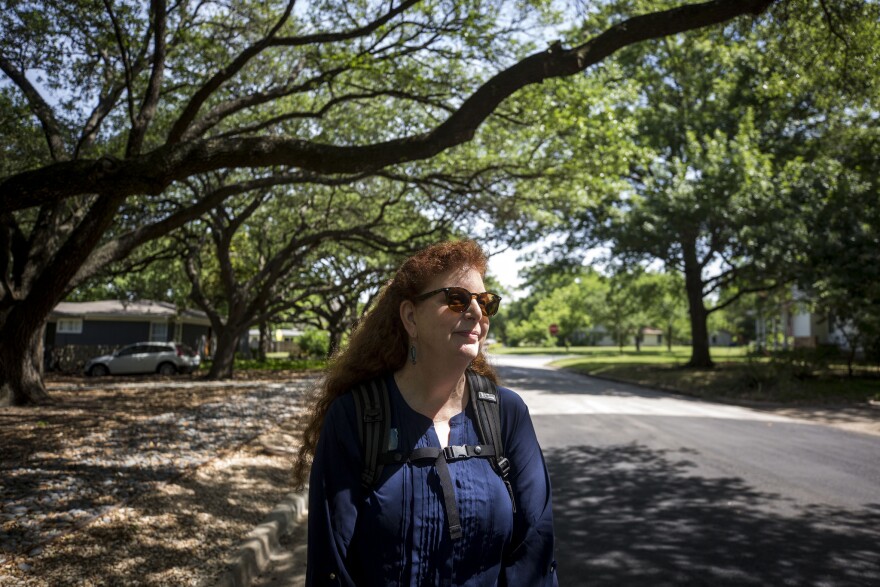Part 3 of a three-part series
A driver hit and killed Judy Romano’s son, Barry Friedman, while he was walking in Austin two years ago.
According to the police report, Friedman tried to cross E. Parmer Lane just before 6 a.m. on July 9, 2016. The driver said Friedman was in the crosswalk even though he didn't have the light to cross.
Romano said she believes Friedman was running to catch the bus to work.
“He was a very positive person,” said Romano, who lives in Baltimore. “Even when things didn’t go well, he believed they would get better.”
Part 1: Two Years After Vision Zero, When Will Austin Streets Be Safer For Pedestrians?
In May 2016, Austin City Council members approved a Vision Zero Action Plan with the goal of reducing traffic deaths and serious injuries on city roads to zero by 2025. Since then, fatal crashes have dropped slightly, but pedestrians still make up roughly a third of the deaths.
The plan hinges on the idea that humans make mistakes while driving, biking and walking – but roads should be designed to absorb these mistakes so they don’t prove fatal.
Some people argue the way law enforcement and at times, society, talk about pedestrian fatalities does not take into account how road design contributes to pedestrian deaths.
Part 2: Housing Austin's Homeless Will Reduce Road Deaths, But That Will Require A Big Investment
In the police reports of pedestrian deaths from 2016 and 2017 that KUT obtained, many cases are deemed “death of offender.” Friedman's death is referred to this way, as is the death of 14-year-old Alexei Bauereis, who was killed in 2016 while walking his bike across an intersection.
Patrick Oborski, a detective with the Austin Police Department Highway Enforcement, said the department uses the phrase “death of offender” when it concludes there’s nothing a driver could have reasonably done to not hit and kill a pedestrian.
“They did a bad thing and made a wrong decision to cross where they shouldn't cross,” Oborski said. “Death of offender” denotes that no criminal charges need to be filed – on the driver, who is found not to be at fault, or the deceased pedestrian.
“Once they come to the determination that the pedestrian did something that's really stupid and cost them their life, they’re not going to, you know, do search warrants on cellphones and the like," he said. "That's not going to matter at that point …You're not going to file criminal charges on someone that's already dead.”
But Heyden Black Walker, an urban planner who serves on the city’s Pedestrian Safety Council, said often the way roads have been built leave pedestrians with few safe options to get around – leading them to make dangerous decisions.
“[Pedestrians] weren't wearing reflective clothing or they were crossing mid-block or they failed to yield to the vehicle,” she said. “We don't always think about how we've left them without choices in a lot of cases.”

Walker cited a 2016 case where a 66-year-old man using a motorized wheelchair tried to cross N. Lamar Boulevard and was hit and killed by a driver. According to Walker, the strip of road where the man was trying to cross has no sidewalks and few crosswalks.
“He became a statistic of someone who is counted as a pedestrian who failed to yield to the motor vehicle,” she said. "But we left him without any other choices.”
The police report on Friedman’s fatal crash goes beyond “death of offender” and broadens, slightly, where blame should go. “[B]ased on these factors it is determined that Friedman’s actions and poor lighting lead (sic) to this crash not the actions of [the driver],” an officer wrote.
Oborski said the department has gotten better about acknowledging the role road design plays in pedestrian deaths.
Kea Wilson, the director of community engagement at the nonprofit Strong Towns, said road design not only affects how law enforcement assigns fault in pedestrian deaths, but also how drivers consider the rights of others to use the streets.
“We've literally engineered it,” she said. Wilson, who lives in St. Louis, said she usually bikes to get around the city. But when she does drive a car, she finds that she begins to prioritize her need to travel above the needs of others.
“I find myself slipping into a higher speed when there are other cars around me that are driving at a speed that isn’t safe for pedestrians," she said.
Tom Wald agreed that when roads are built for cars, drivers believe they have more of a right to them.
“There definitely is just a weird attitude you'll see from people driving,” said Wald, who serves on the board of the nonprofit Walk Austin. “Somehow they have more of a right to be getting around than people who are walking or biking.”
Wald said while he thinks APD has become more considerate about how they assign blame in the cases of pedestrian traffic deaths, he’s still troubled by the fact that the pedestrian is faulted when the driver’s account is all police have.
“The police should be careful about understanding what evidence they have and if they're only relying upon the statement of a driver who hit a pedestrian," he said, "it might just be the conclusion they can draw is inconclusive.”
Police concluded Friedman was not in the crosswalk when he was hit, despite the driver’s recollection that he was.
Despite this, Friedman's mother says it still seems unfair to blame him for his own death – especially since the driver was the only witness.





